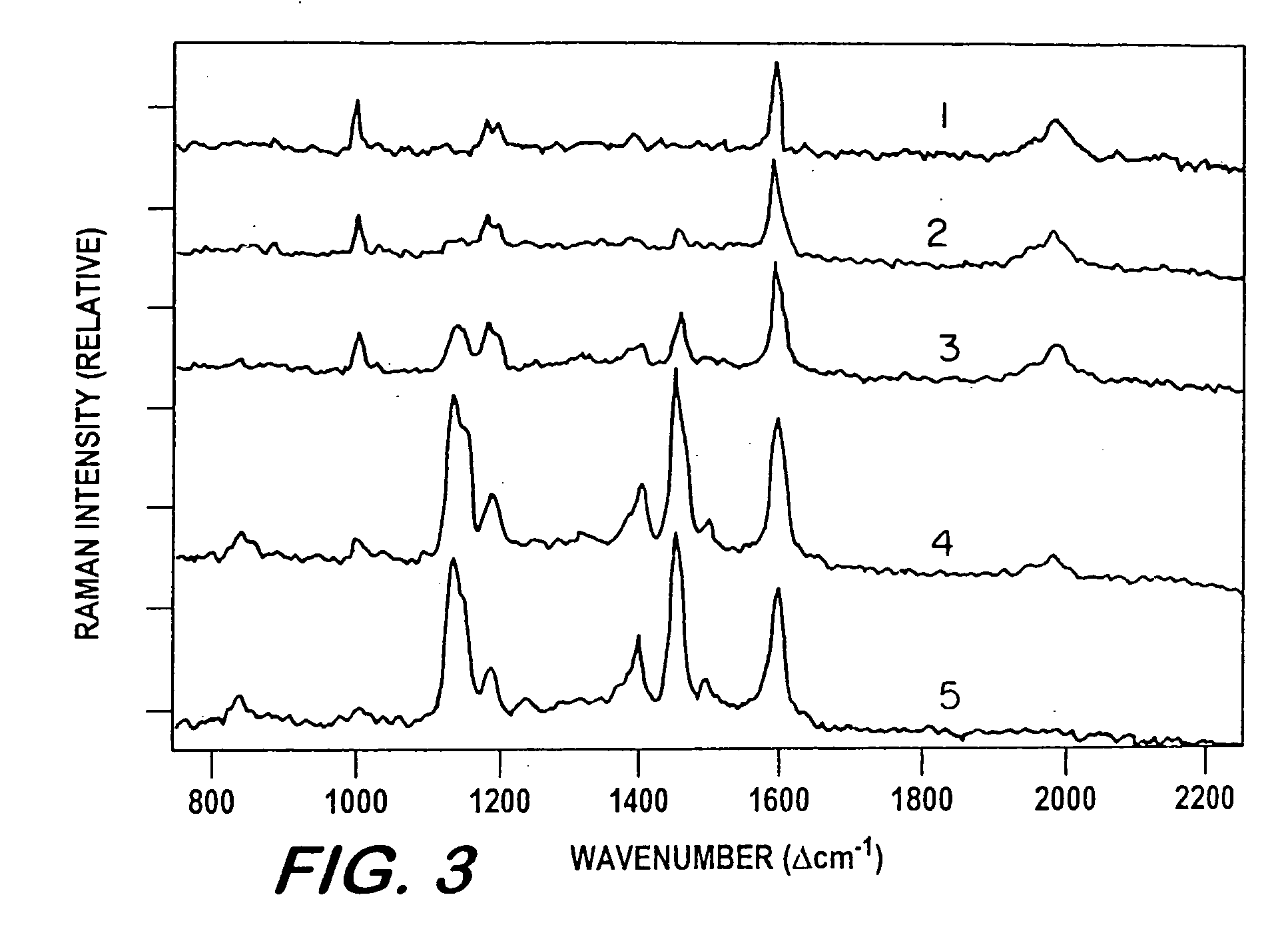Analysis method effected with rapid analyte chemical separation and quick detection
an analysis method and analyte technology, applied in the direction of optical radiation measurement, laboratory glassware, instruments, etc., can solve the problems of incomplete analyte separation prior to the column exit point, not providing any advantage over tlc or lc methods, and limited choice of carrier solvents, etc., to achieve rapid chemical separation, promote scattering radiation, and efficiently distribute samples
- Summary
- Abstract
- Description
- Claims
- Application Information
AI Technical Summary
Benefits of technology
Problems solved by technology
Method used
Image
Examples
example one
[0049]Insofar as the flow of analyte solution is concerned, the following experiment (depicted along the left side of FIG. 1) mimics traditional liquid chromatography. A solution of 8×10−3M p-aminobenzoic acid and 4×10−3M phenyl acetylene was prepared in methanol to demonstrate separation of polar and non-polar chemicals. A 10 μl quantity of the solution was added to the top of a separation and analysis column, constituted and assembled as hereinabove described. A 1 mL quantity of methanol was added as a carrier solvent, and allowed to elute under the forces of gravity and capillary action only. Using an optical probe coupled to a Raman spectrometer, which measured the surface-enhanced Raman spectra at the bottom of the column as a function of time, it was confirmed that the methanol solvent caries the non-polar PA through the column ahead of the polar PABA.
[0050]More specifically, the microscope objective was positioned 0.5 mm from the bottom edge of the 5 mm length of packed sol-g...
example two
[0051]This example demonstrates that techniques can be applied for driving the solution through the column to substantially reduce the distribution and separation time, and thereby the overall analysis time. Thus, a second experiment (depicted along the right side of FIG. 1) employed an identical sample but used a 50 / 50 v / v mixture of methanol and water as the carrier solvent, rather than methanol alone. In addition, a vacuum of 50 cm of Hg was applied for 30 seconds to draw the sample into the column. Due to the addition of water in the solvent, the separation was reversed because, in the present case, the alkoxide, TMOS, used to prepare the sol-gel is hydrophilic (i.e., water carries the polar PABA along the SER-active medium first), demonstrating flexibility of the concept.
[0052]Since the entire length of the packed sol-gel bed was SER-active, moreover, the extent of distribution and separation could be, and was (in accordance with a feature of the instant method), measured by mo...
example three
[0056]As a variant of the system used in Examples One and Two (which employed a silver-doped TMOS-based sol-gel, scraped from the wall of the vial in which it is prepared and packed into a 1 mm diameter glass capillary), this example employs sol-gels that have been gelled and reduced in the capillary. FIG. 5 shows spectra in which the distribution and separation of a mixture of PABA and PA, each at one part per million, was effected. The mixture was prepared by dilution from equal volumes of a solution of 1 mg PABA in 1 mL water, and 0.1 mL PA liquid mixed in 0.9 mL methanol; the sol-gel was prepared from octadecyl silane (ODS) a non-polar stationary phase.
[0057]A 10 microL sample, undiluted by any carrier fluid, was drawn into a 3 cm length of SER-active sol-gel, contained in a 1 mm glass capillary, in 30 seconds using a syringe pump to precisely control the flow rate and effect rapid distribution and separation. The capillary was mounted in front of an objective lens, and spectra ...
PUM
 Login to View More
Login to View More Abstract
Description
Claims
Application Information
 Login to View More
Login to View More - R&D
- Intellectual Property
- Life Sciences
- Materials
- Tech Scout
- Unparalleled Data Quality
- Higher Quality Content
- 60% Fewer Hallucinations
Browse by: Latest US Patents, China's latest patents, Technical Efficacy Thesaurus, Application Domain, Technology Topic, Popular Technical Reports.
© 2025 PatSnap. All rights reserved.Legal|Privacy policy|Modern Slavery Act Transparency Statement|Sitemap|About US| Contact US: help@patsnap.com



